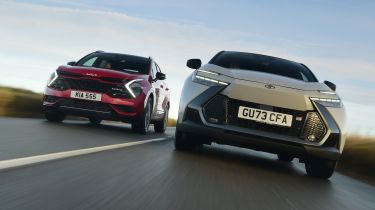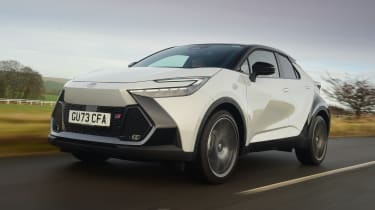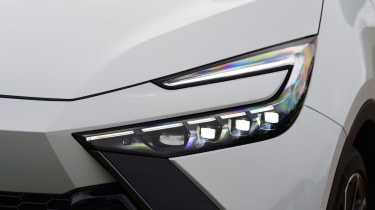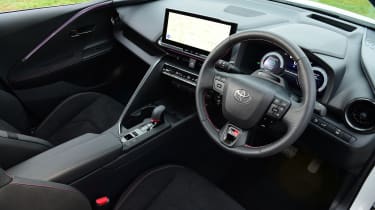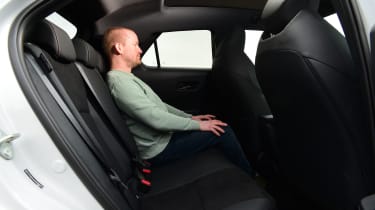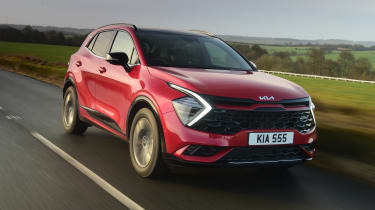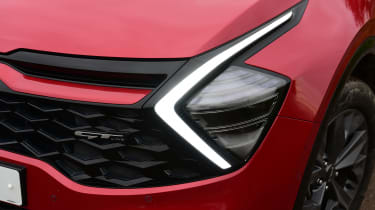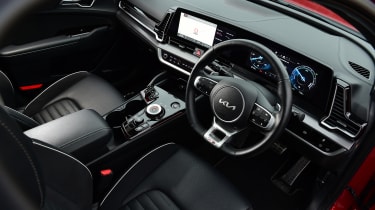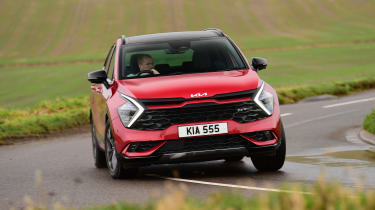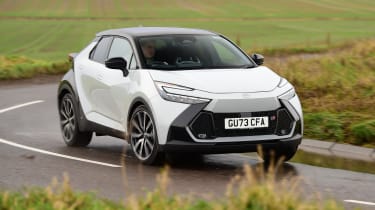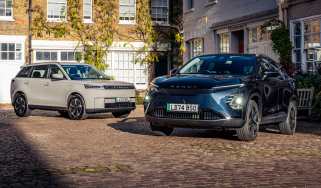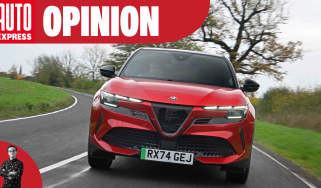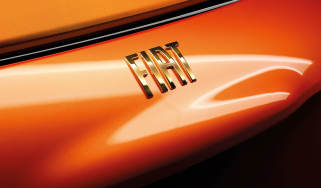Kia Sportage vs Toyota C-HR: can Toyota’s new arrival beat Kia’s best-seller?
Toyota’s Mk1 C-HR was a big hit. Now it’s time for the second-generation car to face one of our favourite family SUVs, the Kia Sportage
In the early 2010s, Toyota had a problem. Its Prius was proving to be an incredibly efficient and dependable family car, but it wasn’t one that hit the spot for style-conscious buyers. With an ever-increasing slice of the new-car market formed by small SUVs, the Japanese giant needed to respond.
The result was the Toyota C-HR: a chunky, distinctive crossover that offered the option of the same petrol-electric technology found in the Prius but in a more desirable package. Seven years on, there’s a new version – and it’s even more striking and smarter than the one before.
But the new car will have a tough challenge on its hands, because its price point pitches it against some stiff competition. For the same money as the C-HR we’re testing, you can have one of our favourite family SUVs, the Kia Sportage, in a high-spec trim and with a hybrid powertrain. But which is best?
| Toyota C-HR 2.0 i-VVTi GR Sport | Kia Sportage 1.6 T-GDi GT-Line S | |
| Price: | £41,625 | £40,675 |
| Powertrain: | 2.0-litre 4cyl hybrid, 193bhp, eCVT auto | 1.6-litre 4cyl turbo hybrid, 212bhp, six-speed auto |
| 0-62mph: | 8.1 seconds | 8.4 seconds |
| Test efficiency: | 48.1mpg/10.6mpl | 42.5mpg/9.3mpl |
| CO2: | 110g/km | 132g/km |
| VED: | £170 | £170 |
Toyota C-HR
Our first in-depth encounter with the Toyota C-HR on UK shores comes in GR Sport trim, but it comes at a price. At £41,625, it’s competing against a fully kitted-out Kia Sportage, which is a larger car. Can the C-HR justify its price point?
Tech highlights
The outgoing C-HR was a huge success for Toyota, with more than 840,000 units being sold across Europe in its six-year life. The car was initially offered with a conventional petrol engine, but Toyota soon quietly dropped this as hybrids formed the vast majority of sales. This time around, the C-HR is available with two hybrid powertrains, but a range-topping PHEV is also on the way.
Used - available now

2018 Mazda
CX-3
64,023 milesManualPetrol2.0L
Cash £10,100
2023 Honda
CR-V
25,120 milesAutomaticPetrol2.0L
Cash £25,990
2022 Nissan
Leaf
36,853 milesAutomaticElectric
Cash £10,600
2021 SEAT
Ibiza
26,482 milesManualPetrol1.0L
Cash £12,550We’re testing the more powerful of the hybrids. Petrol power is supplied by a 2.0-litre four-cylinder engine, which is backed up by a 111bhp electric motor linked to a 2.4kWh battery. This system offers a combined 193bhp, fed to the front wheels via Toyota’s e-CVT automatic transmission.
Under the skin, the C-HR uses the latest version of Toyota’s TNGA architecture. An increased use of high-strength steel has improved rigidity while trimming a few kilos of weight, and the redesigned MacPherson front struts and multilink rear suspension are stronger and lighter than before.
Safety: Crash-test experts Euro NCAP haven’t published safety ratings for the C-HR yet, although every other Toyota product that uses the group’s TNGA platform has scored five stars, so we predict it’ll be a similar story here.
To benefit from the most advanced safety tech, such as front cross-traffic alert, lane-change assist and a panoramic view monitor, you must spend £1,500 for the Safety Pack on this GR Sport trim. Many of those features are standard on the top-spec Excel, but are unavailable on the two lowest trims.
On the road
There's much to like about the way the C-HR drives, with a responsive and smooth hybrid system and an agile yet secure chassis. Ride and refinement are reasonable, but not class leading.
Around town: That hybrid tech is at its best at low speeds. The electric motor is very lively and responsive, which makes three-point turns quick and easy, while the strong initial pick-up means there’s no lag when pulling out of junctions. It’s a level of response that will be familiar to EV owners.
When the battery is depleted, the petrol engine cuts in almost seamlessly, with only a background hum announcing its presence. The steering is light and precise, but the ride is a bit firm. The damping has a high-quality feel, though, and is never harsh.
A & B-roads: That damping quality can be felt at higher speeds, too. Hit a bump, and the C-HR deals with it quickly and confidently, while there’s little body roll in the corners. It’s primarily set up for stability; this C-HR isn’t quite as fun to drive as its predecessor, but it’s very capable and among the more sophisticated-feeling cars in its class.
The hybrid system picks up well at higher speeds, too, but hard acceleration is accompanied by a droning engine note – a side effect of the e-CVT transmission that we can just about forgive for the responsiveness it brings elsewhere.
Motorway: Stability is fine at speed, but even though our GR Sport model gets a noise-reducing windscreen, we still noticed a little more wind rustle than we’d like. The C-HR is efficient, though. Considering the quick 0-62mph time of 8.1 seconds, we still averaged more than 48mpg in a wide range of driving environments, including on a long motorway run.
Ownership
The C-HR’s cockpit really suits the first part of its Coupé-High Rider name; the driving position feels more sporty than many SUVs, and thanks to a lofty centre console, the feeling from the driver’s seat is a little more low-slung than in most alternatives.
The interior design is fairly smart, too, with a wraparound section of the dash giving a driver-focused feel. At a time when so many brands are switching to touchscreen climate controls, the C-HR’s neat bank of toggle switches is something of an ergonomic delight, too. While it’s hard to fault the build quality, and the use of recycled plastics inside has increased by 100 per cent when compared with the last model, the choice of materials isn’t always brilliant. Key touchpoints such as the central armrest are finished in fairly hard, cheap-feeling plastics.
One side effect of the C-HR’s dramatic silhouette, especially around the C-pillars, is that over-the-shoulder visibility is limited. This is compounded by a small rear window which, annoyingly, has no wiper. It’s fine if you happen to be caught in a downpour while you’re already up to motorway speeds, but the window will be streaming with water the moment that things slow down; the droplets don’t simply ‘slide away’, as Toyota claims. Our car came with a digital rear view mirror to compensate for this, but it’s only part of the optional Safety Pack.
Toyota offers a one-year recovery package with the C-HR. While this matches Kia, other rivals come with a more generous three years of cover.
Storage: Interior storage is hit and miss. The cup-holders are deep, the wireless smartphone charging tray ahead of it is large and not only is the glovebox huge, but there’s also a large shelf above it. On the other hand, the door pockets are slim and the central storage bin is small, while in the back there are only small cup-holders.
Practicality
This is the one key area where C-HR owners must be willing to compromise; at this money, the Toyota simply isn’t as spacious as the competition.
Rear Space: For a car that could be potentially used as a family SUV, headroom will be a little tight for some, because that sloping roofline means there’s similar space to what many superminis offer. Rear kneeroom isn’t much better; in fact, we found that the C-HR’s smaller SUV cousin, the Yaris Cross, has a slight edge here. There’s no fold-out central armrest, either.
Boot: More of a compromise, however, is the boot. At 364 litres, it’s small for a car in this class. The load lip is very high, and the space is a little awkward, with pronounced intrusions poking out just ahead of the rear bench. Once those seats are folded, they leave a big step in the load area, too.
What to buy?
Which version we’d choose
- Powertrains: In addition to this 2.0-litre hybrid model, buyers will be able to pick a range-topping 219bhp plug-in version that is claimed to cover up to 41 miles in EV mode. Another full hybrid is offered, with a 1.8-litre petrol engine and 138bhp that undercuts the 2.0-litre version, costing from £31,290.
- Trim: That lower price isn’t just because of the smaller powertrain; the 1.8 is also available in basic Icon trim with 17-inch alloys and an eight-inch touchscreen. Design spec starts from £34,685, and comes with 18-inch wheels, a powered tailgate and rear cross-traffic alert.
- Our choice: The 1.8-litre hybrid costs significantly less. We’d get it in Design trim.
Kia Sportage
To illustrate just how closely matched this pair is on price, our hybrid-powered Kia Sportage GT-Line S test car comes to £40,675 – just £950 less than its rival.
Tech highlights
On the face of it, the Kia’s hybrid powertrain looks as if might fall short of the Toyota’s, because its petrol contribution comes in the form of a 1.6-litre in place of the Toyota’s 2.0-litre unit. But it more than makes up for any shortfall in capacity with a turbocharger. Its electric motor also makes 59bhp, which is a little over half that of the Toyota’s unit.
Combine this with the fact that the C-HR’s engine uses the more fuel-efficient – but less torquey – Atkinson-cycle design, and the Sportage has its rival beaten for grunt across the board. In total, it makes 212bhp and 350Nm of torque – a big step up on the Toyota’s 193bhp and 206Nm. This power is sent to the road through a six–speed dual-clutch automatic gearbox, with front and four-wheel-drive versions available.
However, as the larger, heavier car, the Sportage needs that extra shove, which is why its on-paper performance is very similar to the Toyota’s; an 8.4-second 0-62mph time is only 0.3 seconds shy. Electrical energy comes from a 1.5kWh battery, which means that the Kia can’t rely on zero-emission driving as much as its rival, either.
Safety: The Kia was assessed by Euro NCAP in 2022, and it was awarded a maximum five-star safety rating. Unlike lower Sportage trim levels, this top-spec GT-Line S model comes with a blind-spot collision-avoidance system as standard.
Its adaptive cruise control works with Kia’s Highway Driving Assist system, which can take over steering for short periods – something which helps to reduce fatigue on a long motorway slog.
On the road
These rivals have different road manners, with the Kia proving to be the more comfortable and relaxing option. However, the Sportage’s hybrid system isn’t as slick as the C-HR’s.
Around town: There’s a little sluggishness to the Kia’s throttle response, which is pretty clear if you’ve just jumped into it from the C-HR. You can really feel the difference between the electric motors’ outputs, with the Kia nowhere near as enthusiastic to move off from a standstill. Having less electric power to draw upon, the petrol engine has to wake into life more often, too.
A & B-roads: When the engine does fire up, its note is a little thrashy and unpleasant, which discourages you from using all of the Kia’s power. Fortunately, the more conventional gearbox makes the engine sound a little more natural than Toyota’s 2.0-litre hybrid unit. Get over the initial delay in torque and there’s very little to separate the straight-line performance of this pair of SUVs in the real world.
Through a twisty section of road, the Kia feels slower to react as you initially turn into a corner. There’s more body roll and the steering is slightly heavier, less direct and not quite as precise as the C-HR’s. Hit a big bump in the middle of a corner and the Kia takes an extra beat or two to settle, whereas the Toyota deals with any undulations
much more quickly and more positively.
Motorway: The flipside of this set-up is that the Kia has a smoother ride at any speed. It’s by no means perfect – there’s a touch of fidget around town – but the Sportage is otherwise a relaxing place to be. There’s less wind noise at motorway speeds, but conversely there is more tyre rumble.
Ownership
The latest Sportage took a leaf out of the all-electric EV6’s book on the inside. That means there’s a wide, clean dashboard design, which is relatively clear of buttons, while the pair of infotainment screens blend neatly into each other in the same panel across the top of the dash. The cabin feels broader and more open than the C-HR’s and, while there are some scratchy plastics on the side of the centre console, the main touchpoints feel softer and more expensive than in the Toyota.
At 4,515mm long and 1,645 wide, the Kia is 153mm longer and 81mm taller than the C-HR, and it’s 33mm wider – worth bearing in mind if you live somewhere with parking space at a premium.
Both Kia and Toyota have traditionally put in strong showings in our annual Driver Power customer-satisfaction surveys, and sure enough, both finished comfortably in the top half of the 2023 rankings, with Kia sixth (out of 32 brands) and Toyota 12th. Just 15 per cent of Toyota owners had a fault of any kind within the first 12 months of ownership; only sister brand Lexus, plus Suzuki and Fiat, chalked up better marks in this area.
Should anything go wrong with your Kia, owners benefit from a seven-year, 100,000-mile warranty. While Toyota owners appear to only get a three-year warranty at first glance, those who continue to have their cars serviced at a main dealer on schedule get an additional 12 months’ cover each time. This can run for as long as 10
years after the car has rolled off the forecourt.
Storage: Look down to the doors and the Sportage’s pockets are even slimmer than the C-HR’s. However, the rest of the cabin is well catered for in terms of cubbies; the central bin is large, and the space beside the rotary gear selector can double as an open area or, at the touch of a couple of buttons, two spring-loaded cup-holders pop out to stow drinks on the move.
Practicality
There's only one winner when it comes to interior space in this test; by almost any measure, the Sportage has the C-HR comfortably beaten.
Rear Space: The Kia holds a small advantage over its rival in terms of rear legroom, but it’s above where its benefits are really felt; there’s 93mm more headroom in the back of the Sportage than there is in the C-HR. It’s wider across the cabin and its centre seat is a little more comfortable, too. The backrests are also adjustable, allowing passengers to recline the seats to their preferred angle.
Boot: The Sportage offers a vast 587-litre boot, a figure that puts it right towards the top of its class, and almost a Toyota Aygo X’s boot ahead of the C-HR’s volume. There’s a little wheelarch intrusion to the sides, but the space overall is wide, square and with a minimal boot lip to overcome.
What to buy?
Which version we’d choose
- Powertrain: All versions of the Sportage come with a variation of a 1.6-litre turbocharged petrol engine. Buyers get a choice of conventional petrol and mild-hybrid units, stepping up to the hybrid we have here. At the top, there’s also a PHEV, but as in this comparison, the Kia’s hybrid stats can’t quite live with those of the equivalent Toyota. The four-wheel-drive hybrid costs £1,600 more than the front-wheel-drive model.
- Trim: In a slightly confusing naming structure, the range starts with 2, then GT-Line, 3, and GT-Line S at the top. The base trim isn’t available with the hybrid.
- Our choice: We’d go for the 3 HEV; it isn’t short on kit, but costs more than £4,000 less.
Results
Which car comes out on top?
Winner: Kia Sportage
The Sportage needed to see off some stiff competition here, but it has once again proved why it’s among the class-leading family SUVs. A comfortable-yet-composed chassis is backed up by a stylish cabin, high equipment levels and a huge amount of space – both for passengers and their things.
This encounter with the C-HR has proven that Kia’s hybrid tech has room for improvement in terms of both response and efficiency, but otherwise the Sportage is an excellent all-rounder.
| Pros | Cons |
| Generous equipment | Less efficient than C-HR |
| Better rear-seat space | Lower trims are better value |
| Comfortable ride | Not the most fun to drive |
| Huge boot | Rough petrol engine |
Runner-up: Toyota C-HR
That the C-HR runs the Kia close in an overpriced trim level shows how strong this new Toyota is. There’s only one clear downside to the car, and that’s practicality; the interior and boot are much more cramped than in rivals costing similar money.
That aside, it’s an impressive second attempt at the stylish crossover market. Save a large chunk of cash and get one of the lesser trim levels – and live with the drop in power – and you’ll get a sophisticated and distinctive SUV.
| Pros | Cons |
| Efficient hybrid tech | Cramped cabin |
| Smart handling | Small boot |
| Slick infotainment system | Wind noise |
| Strong performance | Some safety kit costs extra |
Rivals and other options
The Sportage wins our twin test, but what else is out there?
- Same money: Hyundai Tucson
- Same class: Nissan Qashqai
- Used: Toyota C-HR (Mk1)
- Used: Audi Q3
- Coming soon: Volkswagen Tiguan
The great debate
What the Auto Express test team would do…
John Mcllroy, editor–at–large: “In time, we hope that Toyota will consider offering the 2.0-litre with lower trim levels. Based on the price gaps between the existing C-HR powertrains, a 2.0-litre in base Icon trim could sneak under £33,000 – at which point it becomes a very tempting proposition.”
Richard Ingram, deputy editor: “Kia has been on a huge roll in the past few years, and that form only looks set to continue. The brand’s all-electric models are the strongest in its range, and an all-new model, the EV3, will offer buyers a slightly more compact but battery-powered alternative to the Sportage.”
Dawn Grant, picture editor: “It's the little details that help you tell that Kia has really put a lot of thought into designing the Sportage with families in mind. Take the USB-C ports in the back; they’re mounted on the side of the front seats, which makes them really easy to reach when your phone or devices need a top-up.”
Steve Fowler, editor-in-chief: “The previous C-HR took the eco-conscious Prius hybrid and gave it an SUV twist. A new C-HR means there’s a new Prius, too; it wasn’t going to come to the UK at first, but Toyota has changed its mind. This time around it’s PHEV only, but an ultra-slippery shape makes it more efficient than ever.”
Dean Gibson, senior test editor: “Toyota keeps making constant gains with its hybrid tech, evident here with the C-HR’s hybrid battery; it’s 1.5kg lighter and more compact than the old unit, but stores 14 per cent more power. At high speeds, the eCVT drops engine revs 500rpm lower than before for quieter cruising.”
Which would you buy? Let us know in the comments section below…
Specs and prices
| Toyota C-HR 2.0 VVT-i GR Sport | Kia Sportage HEV 1.6 T-GDi GT-Line S | |
| On the road price/total as tested | £41,625/£42,125 | £40,675/£40,675 |
| Residual value (after 3yrs/36,000) | £21,096 (50.68%) | £23,526 (57.84%) |
| Depreciation | £20,529 | £17,149 |
| Annual tax liability std/higher rate | £2,182.41/£4,364.80 | £2,501.39/£5,002.80 |
| Annual fuel cost (10k/20k miles) | £1,321 (£2,643) | £1,495 (£2,991) |
| Ins. group/VED | 27/£170 | 25/£170 |
| Service costs (3 years) | £1,083 | £669 |
| Length/wheelbase | 4,362/2,640mm | 4,515/2,680mm |
| Height/width | 1,564/1,832mm | 1,645/1,865mm |
| Engine | 4cyl in/1,987cc | 4cyl in turbo/1,598cc |
| Hybrid system | 111bhp e-motor, 2.4kWh battery | 59bhp e-motor, 1.5kWh battery |
| Peak power | 193bhp | 212bhp |
| Peak torque | 206Nm | 350Nm |
| Transmission | e-CVT/fwd | Six-speed auto/fwd |
| Boot capacity | 364 litres | 587 litres |
| Kerbweight/payload/towing weight | 1,515/415/725kg | 1,649/526/1650kg |
| Fuel tank capacity/spare wheel | 43 metres/repair kit | 52 metres/repair kit |
| Basic warranty/recovery | 3yrs (60k)/1 yr | 7 yrs (100,000)/1 yr |
| Driver Power manufacturer/dealer position | 12th | 6th |
| Euro NCAP: Adult/child/ped./assist/stars | N/A | 87/86/66/72/5 (2022 |
| 0-62mph/top speed | 8.1 secs/112mph | 8.4 secs/113mph |
| Auto Express economy/range | 48.1/455 | 42.5/486 |
| WLTP combined | 57.6mpg | 51.4mpg |
| Actual/claimed CO2 | 136/110g/km | 154/132g/km |
| Number of airbags/Isofix points | Seven/two | Six/two |
| Parking sensors/camera | F&r/yes | F&r/360 |
| Lane-keep assist/blindspot/AEB | Yes/£1,500*/yes | Yes/yes/yes |
| Climate control/adaptive cruise | Dual-zone/yes | Three-zone/yes |
| Leather/heated seats/wheel | No/yes/no | Part/yes/yes |
| Metallic paint/LED lights | £0/yes | £0/yes |
| Keyless entry & go/powered tailgate | Yes/yes | Yes/yes |
| Sat-nav/digital dashboard/USBs | Yes/yes/three | Yes/yes/four |
| Online services/wireless charging | Yes/yes | Yes/yes |
| Apple CarPlay/Android Auto | Yes/yes | Yes/yes |

